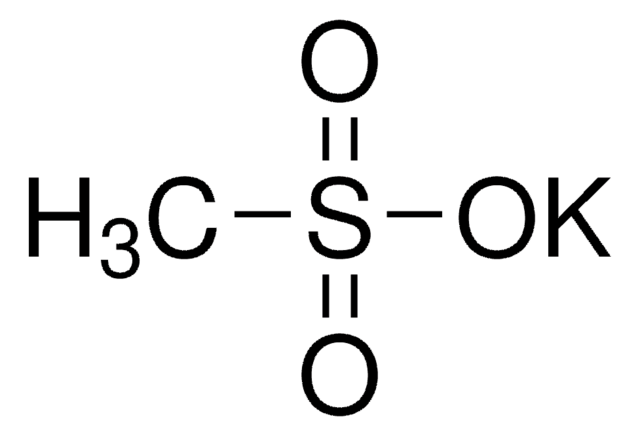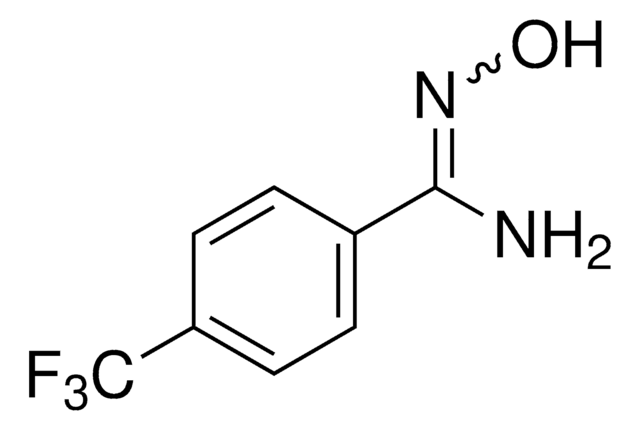Alle Fotos(3)
Wichtige Dokumente
P8131
Kaliumhexacyanoferrat(III)
ReagentPlus®, ~99%
Synonym(e):
Kaliumferricyanid, Rotes Blutlaugensalz
Anmeldenzur Ansicht organisationsspezifischer und vertraglich vereinbarter Preise
Alle Fotos(3)
About This Item
Lineare Formel:
K3Fe(CN)6
CAS-Nummer:
Molekulargewicht:
329.24
EG-Nummer:
MDL-Nummer:
UNSPSC-Code:
12352302
PubChem Substanz-ID:
NACRES:
NA.21
Assay:
~99%
Form:
powder or crystals
Empfohlene Produkte
Qualitätsniveau
Produktlinie
ReagentPlus®
Assay
~99%
Form
powder or crystals
pH-Wert
6-9 (25 °C, 329 g/L)
SMILES String
[K+].[K+].[K+].N#C[Fe-3](C#N)(C#N)(C#N)(C#N)C#N
InChI
1S/6CN.Fe.3K/c6*1-2;;;;/q;;;;;;-3;3*+1
InChIKey
MIMJFNVDBPUTPB-UHFFFAOYSA-N
Suchen Sie nach ähnlichen Produkten? Aufrufen Leitfaden zum Produktvergleich
Verwandte Kategorien
Allgemeine Beschreibung
Potassium hexacyanoferrate(III) can be used as a one-electron oxidant for the oxidation of quinolines, thiamines, and cyclic amines.
Anwendung
- Enzymatic synthesis of a skin active ingredient - glochidone by 3-ketosteroid dehydrogenase from Sterolibacterium denitrificans: Highlighting the utilization of Potassium hexacyanoferrate(III) in biochemical applications, specifically in enzymatic reactions involving steroid conversion processes (Wojtkiewicz AM et al., 2024).
- ZIFs-Derived Hollow Nanostructures via a Strong/Weak Coetching Strategy for Long-Life Rechargeable Zn-Air Batteries: Demonstrates the role of Potassium hexacyanoferrate(III) in creating nanostructured materials for enhanced electrochemical energy storage, pertinent to battery technology (Li S et al., 2024).
- Development of an electrochemical impedance spectroscopy immunosensor for insulin monitoring employing pyrroloquinoline quinone as an ingestible redox probe: Incorporates Potassium hexacyanoferrate(III) for developing advanced biosensors with applications in healthcare diagnostics (Khanwalker M et al., 2024).
- Selective gold extraction from electronic waste using high-temperature-synthesized reagents: This study uses Potassium hexacyanoferrate(III) in novel methodologies for the recovery of precious metals from electronic waste, offering a sustainable approach to waste management and recycling (Li J et al., 2024).
- Tunable Electrochemical Entropy through Solvent Ordering by a Supramolecular Host: Explores the chemical versatility of Potassium hexacyanoferrate(III) in creating responsive molecular environments for energy systems, underlining its importance in materials science and thermodynamic studies (Xia KT et al., 2023).
Rechtliche Hinweise
ReagentPlus is a registered trademark of Merck KGaA, Darmstadt, Germany
Signalwort
Warning
H-Sätze
Gefahreneinstufungen
Aquatic Chronic 2 - Eye Irrit. 2
Zusätzliche Gefahrenhinweise
Lagerklassenschlüssel
13 - Non Combustible Solids
WGK
WGK 2
Flammpunkt (°F)
Not applicable
Flammpunkt (°C)
Not applicable
Hier finden Sie alle aktuellen Versionen:
Besitzen Sie dieses Produkt bereits?
In der Dokumentenbibliothek finden Sie die Dokumentation zu den Produkten, die Sie kürzlich erworben haben.
Kunden haben sich ebenfalls angesehen
Simultaneous detection of thiamine and its phosphate esters from microalgae by HPLC
Pinto E, et al.
Biochemical and Biophysical Research Communications, 291, 344-348 (2002)
Osmium (VIII)-catalyzed oxidation of some cyclic amines by potassium hexacyanoferrate (III) in alkaline media: A kinetics and mechanistic study
Al-Subu M, et al.
Chemistry of Heterocyclic Compounds, 39, 478-484 (2003)
Behaviour of cooxidation of isopropyl ether of vitamin A with cumene in chlorobenzene
VaRdanyana R, et al.
Oxidation Communications, 36, 845-851 (2013)
Kinetics of Oxidation of Some Fluoroquinolones by Hexacyanoferrate (III) in Alkaline Medium
Diab N, et al.
International journal of chemistry research, 34, 1388-1388 (2013)
Catherine M Czeisler et al.
The Journal of physiology, 597(8), 2225-2251 (2019-02-02)
The embryonic PHOX2B-progenitor domain generates neuronal and glial cells which together are involved in chemosensory control of breathing and sleep homeostasis. Ablating PHOX2B-derived astrocytes significantly contributes to secondary hypoxic respiratory depression as well as abnormalities in sleep homeostasis. PHOX2B-derived astrocyte
Unser Team von Wissenschaftlern verfügt über Erfahrung in allen Forschungsbereichen einschließlich Life Science, Materialwissenschaften, chemischer Synthese, Chromatographie, Analytik und vielen mehr..
Setzen Sie sich mit dem technischen Dienst in Verbindung.





